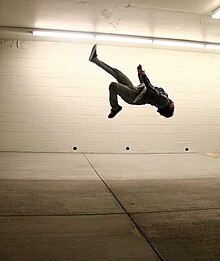
Tricking is a training discipline that combines kicks with flips and twists from martial arts and gymnastics as well as many dance moves and styles from dance. It is a martial art that borrows techniques from taekwondo, takkyeon, wushu, capoeira, and more. It aims to achieve an aesthetic display of different combinations of "tricks". Tricking practitioners are commonly referred to as trickers. Examples of tricking techniques include the 540 kick, the corkscrew (cork), the flashkick, the butterfly twist and the double leg.
A tendency to exhibit techniques that are more flashy and complex was observed in martial arts during the period following the 1960s, predating the current tricking movement. Especially in taekwondo, an increasing emphasis on spectacular spinning, jumping or flying kicks developed during the mid-1960s with the introduction of international competitions.[1]
The actual sport of tricking is an internet phenomenon, emerging in the early 2000s.[citation needed] Xtreme Martial Arts is thought to be a close precursor to the sport, being shown at various martial arts tournaments in the 90s and early 2000s.[citation needed] By late 2003, the online tricking community was well-developed, bringing trickers from across the globe together. With the rise of YouTube, trickers were able to share their videos with others, and the discipline experienced a massive rise in popularity and interest.[citation needed]

Unlike many established sports, tricking has no formal rules or regulations, and there are no governing bodies that regulate the sport. Strictly speaking, participants are free to perform any kind of dramatic maneuver and call it a 'trick' - though there are certain moves that are generally accepted as tricking moves. Some practitioners (especially those who discover tricking through the Internet) tend to learn the easier moves first (such as the 540 kick, aerial, kip-up, and backflip) and try to progress through a list of recognized tricks in the perceived order of difficulty. However, how difficult a trick is, varies from person to person; certain tricks may be inexplicably easier or harder than normal for a particular tricker to learn.
Trickers can be divided into different categories of style: some prefer performing mainly martial arts tricks (which almost always incorporate kicks into a trick), others mostly freestyle gymnastics and flips (mainly focus on combining different types of rotations and twists), but most trickers combine moves from both of the disciplines. Trickers regularly train their bodies hard to be able to perform their tricks at any time consistently.
| Category | Prerequisites | Tricks Name | Description | Variation |
|---|---|---|---|---|
| Flipping | ||||
| Rolls | Forward Rolls | Roll forward starting from feet | Dive Roll, 360 Dive Roll, Webster Dive Roll | |
| Backward Rolls | Roll backward starting from feet | Arabian Dive Roll | ||
| Handspring | Handstand + Forward Rolls | Front Handspring | Forward Flip using hands and Feet In Handstand Position | Flyspring |
| Bridge stretch + Backwards Rolls | Back Handspring | Backwards Flip using hands and Feet In Handstand Position | 360 Back Handspring | |
| Handstand | Cartwheel | Sideways Rolls using hands and Feet In Handstand Position | Roundoff, Single handed Cartwheel, Helicopter | |
| Flips | Forward Rolls | Front Flips | Forward Flip starting from feet landing on feet | Front Half, Front Full, Rudi... |
| Front Flips | Webster | Single legged Front Flips | Webster Dive Roll | |
| Backward Rolls | Back Flips | Backwards Flip starting from feet landing on feet | Back Layout | |
| Back Flips | Gainer | Single-legged Back Flips | Cheat Gainer | |
| Gainer | Gainer Flash | Also known as Flash Kick, a Gainer with a Flash Kick | ||
| Gainer | Moon Kick | A Gainer with a Hook Kick | ||
| Side Rolls + Front Flips | Side Flips | Sideways Flip starting from feet landing on feet with head on flat axis | Side Flips fulls, | |
| Cartwheel | Aerial | A Cartwheel without using both hands,by facing front or side | Front Aerial, Side Aerial | |
| Kicking | ||||
| Basic | Round Kick | |||
| Hook Kick | ||||
| Front Sweep | Mostly uses as a transitional move | |||
| Back Sweep | Mostly uses as a transitional move | |||
| Round Kick | Crescent Kick | |||
| Hook Kick | Compasso | |||
| Butterfly Kick (B-Kick) | Also known as B-Kick | |||
| > 180° | Pop + Crescent Kick | 360 Kick | Also known as Tornado Kick | Cheat 360, Pop 360 |
| 360 Kick + Hook kick | 540 Kick (pop 10) | 1.5 Twisting Hook Kick | Cheat 540, Pop 540 | |
| 540 Kick + Round Kick | 720 Kick (pop 12) | Double Twisting Round Kick | Cheat 720, Pop 720 | |
| Twisting | ||||
| Half twits | Full Twist | A 360° twist | ||
| Butterfly Kick + Full Twist | Butterfly Twist | A Butterfly Kick with a 360° twist | ||
| Gainer + Full Twist | Corkscrew (Cork) | A Gainer with a 360° twist | ||
| Set-ups | ||||
| Cartwheel | Scoot | one-handed Lunge into 180 | ||
| Cheat Step | An additional 180° step before tricks, mostly use in Kicking | |||
| J - Step | alternating steps into swing | |||
| Euro Step | single leg Jump landing back on the same leg into swing | |||
| Master Scoot, Gumbi | Raiz | alternating steps into front half | ||
| Raiz | Touch Down Raiz (TDR) | A powerful Setup used in advanced tricks | ||